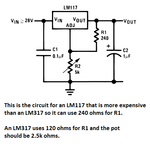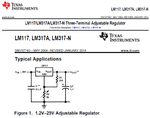gauravkothari23
Advanced Member level 2
hi all....
i have a problem in getting output from lm317 ic. i am having a 12.5v input and expecting a ouput from range 3v to 8v. but the voltage does'nt drops below 11.50v. have also cheked the pin connection and also the datasheet. have also tried replacing the IC twice... but the problem contines. am also attaching my circuit diagram.
- - - Updated - - -
have also tried using 56 ohms resistance(R2). in this case the minimum voltage i get is 5v. but the voltage fluctuates a lot nearly 1v per sec. it does not stays stable.
i have a problem in getting output from lm317 ic. i am having a 12.5v input and expecting a ouput from range 3v to 8v. but the voltage does'nt drops below 11.50v. have also cheked the pin connection and also the datasheet. have also tried replacing the IC twice... but the problem contines. am also attaching my circuit diagram.
- - - Updated - - -
have also tried using 56 ohms resistance(R2). in this case the minimum voltage i get is 5v. but the voltage fluctuates a lot nearly 1v per sec. it does not stays stable.




